|
Report from
Europe
Innovation is key to success
The International Hardwood Conference (IHC) held in
Copenhagen from 16-18 September identified access to
raw materials, changes in global trade flow patterns and
growing purchasing competition with buyers from other
parts of the world as well as innovation in non-wood
materials as key challenges currently facing the European
hardwood industry.
At the same time, however, the conference also
highlighted European countries& common goals and
interests in their commitment to the sustainable use of
hardwoods and the promotion of an increased use of
wood.
The benefits of wood as an environmentally friendly,
sustainable building material were emphasised as a major
advantage in this context, as was Europe&s advanced
educational system in the fields of architecture and wood
engineering.
Innovation, creativity, new and high-end applications for
hardwood as well as tapping into new markets were
considered key to success.
Presentations held in the morning of the conference
primarily focused on trade flow trends in the global and
European markets as well as on the situation in major
hardwood exporting and importing markets in Europe, the
USA, Asia and Africa.
In the afternoon, the focus shifted to the sustainable and
creative use of wood in architecture, and furniture
production as well as on new market opportunities for
hardwoods.
China and Asia dominate the timber trade
Rupert Oliver, speaking on behalf of the EU-funded and
ITTO-hosted FLEGT Independent Market Monitoring
(IMM) project, opened the Conference with an overview
of global hardwood markets. He showed that the global
value of hardwood trade, adjusted for inflation, had
rebounded close to pre-crisis levels in 2014.
The total value of global trade in hardwood products
(including logs, sawn, mouldings/decking, veneer, and
plywood) was around US$38.5 billion in 2014, an increase
of 10% on the previous year (Chart 1).

Analysis of the various product groups reveals that the
upward trend was heavily dependent on a sharp increase in
the global hardwood log trade.
In fact, the total value of global trade in hardwood logs, at
around US$11.1 billion in 2014, was significantly higher
than the previous peak in 2007 (when global hardwood log
trade was US$9.2 billion).
The value of global trade in all other hardwood materials 每
sawn wood, mouldings, veneer and plywood - still falls
short of the peak just prior to the financial crises that hit
western industrialised nations in 2008 (Chart 2).
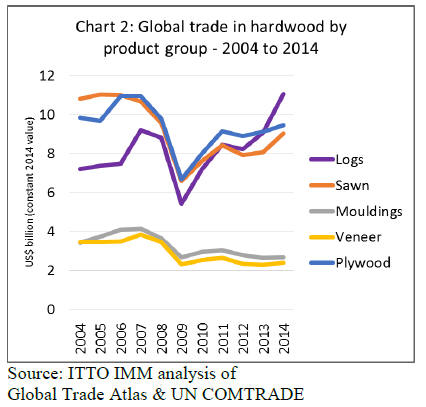
These trends are largely explained by the regional shift in
global hardwood trade since the financial crisis (Chart 3).
The value of China&s hardwood imports doubled between
2009 and 2014, to more than US$12bn.
Although China&s imports of sawn hardwood have been
rising, growth is still heavily concentrated in logs. The
value of China&s log imports increased from just over
US$2 billion in 2009 to close to US$7 billion in 2014.
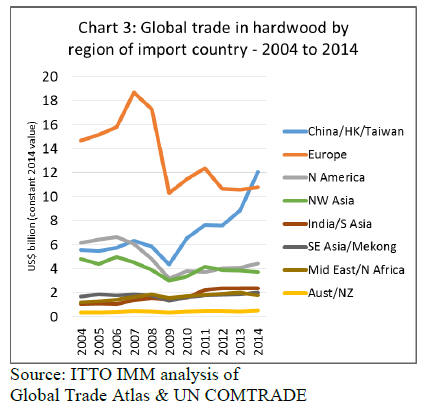
Meanwhile the influence of Europe - traditionally a large
buyer of further processed products like sawn wood,
veneers or mouldings - has declined in global hardwood
trade flows.
The total value of hardwood imports by European
countries (including intra-EU trade), fell from more than
US$18bn in 2007 to just over US$10bn in 2009. The total
value of hardwood imports by European countries has
remained broadly flat since then.
In terms of hardwood export value, the large volume of
intra-regional trade means that, in total, European
countries remain the largest source of internationally
traded hardwoods (Chart 4). In 2014, European countries
exported hardwoods with a total value of US$10.8 billion,
2% more than the previous year but well below the peak
level of US$18.7 billion recorded in 2007.
The increase in European country exports last year was
driven partly by improved consumption in the UK and
Spain and partly by rising sales of hardwood logs and
sawnwood to countries outside Europe, notably China and
Egypt.
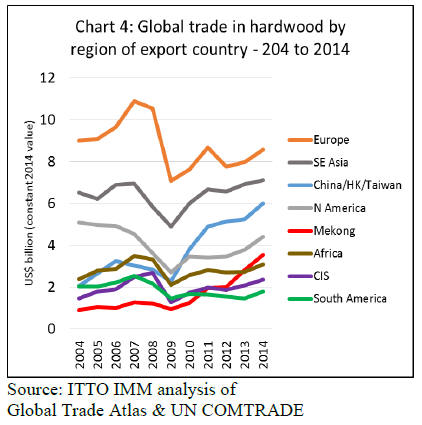
However, the value of hardwood exports by countries in
other parts of the world has been rising more rapidly.
There&s been a particularly rapid rise in the value of
exports by China (dominated by plywood) and by
countries in the Mekong delta region (including both
rubber wood and hongmu species, both destined primarily
for China).
The value of exports by the USA has also been rising with
a significantly higher proportion now destined for China
and South East Asia and a lower proportion destined for
Canada, Mexico and Europe.
Considering just sawn wood, Mr. Oliver showed that
global trade in temperate hardwoods recovered much
faster than tropical wood following the financial crisis
(Chart 5).
In fact global trade in sawn temperate hardwood reached
10.77 million m3 in 2014, 13% higher than the previous
year and just exceeding the previous peak in global trade
of 10.75 million m3 in 2006.
Global trade in sawn tropical hardwood also increased
sharply in 2014, rising 12% to reach 8.99 million m3.
However, this level is still 12% down on peak levels in
excess of 10 million m3 prior to the crises.
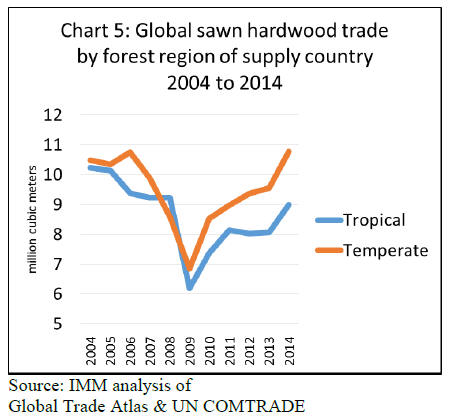
As major 求barriers′ to expansion of hardwood markets in
Europe, Mr. Oliver identified the difficulties arising from
the global financial crisis, product innovations in nonwood
materials, the shift in global economic activity and
hardwood supply to emerging markets, freight and
transport issues, EU production of wood-based panels and
surfacing technologies and exchange rate movements,
among other things.
On the other hand, new opportunities for hardwood are
being created in Europe from increased use of wood in
green building, interest in hardwood in higher-value
structural applications, innovations such as thermal
modification which extend applications for less durable
species, rising awareness of carbon credentials,
certification and legality verification as well as architects&
and structural engineers& increased knowledge of timber.
European hardwood production stable at 6 million
cu.m
Jean-Francois Guilbert of French Timber assessed the
European market from the perspective of the European
hardwood sawmillers. Sawn hardwood production in
member countries of European Sawmillers Organisation
(EOS) was flat at around 6 million cubic meters per year
between 2010 and 2014. Production is expected to remain
at the same level in 2015 (Chart 6).
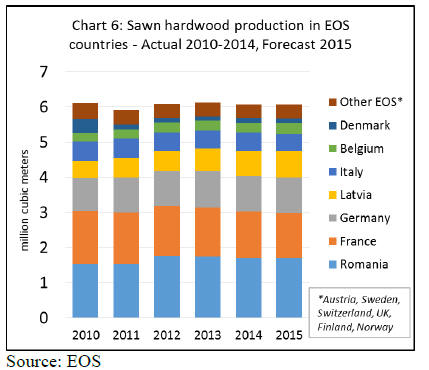
There have been minor shifts in European sawn hardwood
production in recent years. Production in Romania, the
largest supplier (mainly of beech) was rising between
2010 and 2013, but declined 3% to 1.70 million in 2014.
Production in France, which has been declining slowly
since 2010, fell a further 4% to 1.33 million m3 in 2014.
Production in Germany fell 3% to 1.0 million m3 in 2014.
However production in Latvia has been rising over the last
5 years and increased a further 9% to 717,000 m3 in 2014.
Mr. Guilbert noted that exports to non-European countries,
particularly China, were an increasingly important driver
of production trends in the European sawn hardwood
sector. Large quantities of European oak and beech logs
are now destined for China which is making roundwood
sourcing increasingly difficult for European sawmills.
However China is also an important market for European
sawn wood, particularly oak. Sales of European sawn oak
have remained relatively strong in China this year despite
the recent economic slowdown. This was partly attributed
to the weakness in the euro, which has given European
timber a competitive advantage over hardwood traded in
US dollars.
The weak euro has also helped sales in Egypt, Mexico and
the USA. Within Europe, Mr. Guilbert identified the UK
as a key market for sawn oak. For beech, Spain and Poland
are important markets within Europe while Egypt is
recovering strongly outside Europe.
Mr. Guilbert noted that, such is the strength of
international demand, European sawmills could sell
considerably more but production is now constrained by
limited log availability.
While this is partly due to high log exports to China, other
factors include increased fragmentation of private forest
estates and reduced focus on commercial timber
exploitation, the long-term lack of incentives for
plantation establishment throughout much of Europe, and
fierce competition for hardwood logs from the wine
industry (mainly oak) and energy sector.
No real recovery in hardwood consuming sectors
ETTF President Andreas von Möller spoke about recent
trends in the European sawn hardwood market from the
perspective of importers. He noted that at a European
level, key hardwood-consuming industries in Europe -
including construction, furniture, wood flooring and
windows - had shown little or no recovery since the
financial crises. He also stressed that developments
differed greatly from one European country to the next.
The furniture industry, for example, which EU-wide was
still below pre-crisis levels in 2014, was growing strongly
in Poland. Construction is good in Germany and the UK
and recovering in Spain and the Netherlands, while France
and Italy are still experiencing a downward trend.
More positively, Mr. von Möller noted that total imports
of sawn hardwood into the EU28 were 1.97 million m3 in
2014, a rise of 9% compared to 2013. Imports have also
continued to rise in 2015, reaching 1.1 million m3 in the
first five months of the year, up 11% compared to the
same period in 2014.
However Mr. von Möller echoed Mr. Oliver&s assessment
that temperate hardwoods have generally performed better
than tropical hardwoods in the EU market in recent years.
EU imports of temperate sawn hardwood were 1.10
million m3 in 2014, 12% up on the previous year and 41%
down compared to before the financial crisis.
This compares to tropical sawn hardwood of which
960,000 m3 were imported in 2014, 5% up on the previous
year but still 63% down compared to before the financial
crisis. Much of the gain in EU imports of sawn hardwood
in 2015 is due to rising trade with Ukraine, Belarus and
Russia (Chart 7).
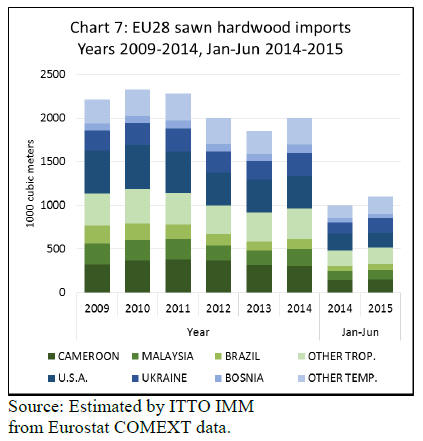
Mr. von Möller also reported that the latest sawn
hardwood import data indicates widely varying market
conditions between EU member states this year. Imports
declined in several large EU markets in the first five
months of 2015, including the UK, Germany, Italy and the
Netherlands. In fact amongst the five largest markets, only
Belgium has increased imports this year.
However imports into several smaller EU markets have
registered double-digit percentage growth this year
including Poland, Austria, Lithuania, Spain, Estonia,
Slovenia, Hungary, Romania, Ireland and Croatia (Chart
8).
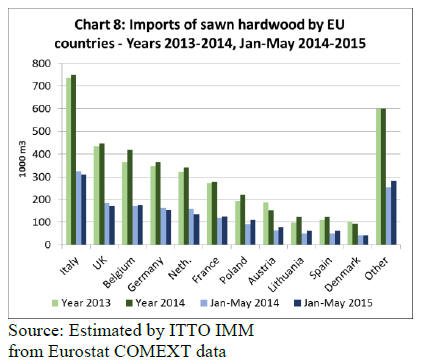
Mr. von Möller went on to identify a number of key trends
in the European sawn hardwood sector. Darker woods are
currently favoured compared to light/reddish coloured
timbers. In flooring, there continues to be a fashion for
wider planks, particularly with 求rustic′ character. Narrow
planks with 求plastic′ appearance lacking character and
natural features are less favoured.
He noted that there is regular on-going substitution 每
driven by price fluctuations and exchange rates 每 between
American tulipwood and beech on the one hand, and a
range of tropical species on the other, including
wawa/ayous/obeche and limba.
Distribution networks for sawn hardwood in Europe have
also undergone profound change since the financial crises.
Generally there is now a strong preference for sourcing
internally from elsewhere in Europe rather than importing
from overseas.
There&s much less willingness on the part of many
European manufacturers and distributors to hold stock and
a strong preference for buying from other European
operators as and when products are needed. European
operators are now much more inclined than in the past to
spend time searching around a wide range of suppliers for
the lowest price rather than to depend on a few regular
suppliers.
There&s also a much greater tendency to buy mixed
container loads with smaller volumes of product in each
specification than to buy full container loads of a single
specification.
Timber-sector players worldwide are interdependent
Presenting to IHC on the Asian hardwood market
situation, Ms. Sheam Satkuru-Granzella, Director of the
Malaysian Timber Council&s European office, highlighted
the importance of global interlinkage and interdependence
in the timber trade.
She underlined the importance of China and India as wood
consuming and remanufacturing countries and observed
that current weakness in the Chinese market would
significantly impact developing countries, particularly in
Africa and Papua New Guinea.
Ms. Satkuru-Granzella noted the growing importance of
the Chinese domestic market as opposed to the re-export
business. She also observed that while there has been
recent strong growth in China&s imports of red 求hongmu′
timbers, China&s market for more modern furniture and
finishing in lighter shades is also growing rapidly.
In Europe, Ms. Satkuru-Granzella identified on-going
economic consolidation as well as weakness in the
European construction sector, with no major changes
expected in the short-term, as major challenges facing the
Asian hardwood business in Europe. She emphasised that
Asian hardwood producers are focusing elsewhere due to
subdued European demand.
She also mentioned implementation of the EUTR as
another challenge, noting problems associated with
inconsistent application of the regulation across the EU.
Structural changes in US hardwood production and
sales
Mike Snow, Executive Director of the American
Hardwood Export Council, spoke about structural changes
in the US hardwood industry that increased the sector&s
emphasis on exports in recent years. Total US hardwood
production peaked as long ago as 1999 and, after sliding
for a few years, fell sharply by 49.3% between 2005 and
2009.
US hardwood production started to recover from 2009 but
is still way below peak levels. It&s also well below
potential: as harvest has remained well below growth the
volume of hardwood standing in US forests has more than
doubled to over 11 billion cubic metres in the last 50
years.
Mr. Snow noted that while demand for hardwood in some
industrial sectors in the US has been rising, there has been
a long term decline in US domestic consumption of graded
lumber in the furniture and construction sectors.
US lumber production has shifted from around 60% grade
and 40% industrial lumber to 40% grade and 60%
industrial. The vast majority of the graded lumber
produced in the US is now exported.
In terms of US hardwood lumber exports, China and other
Asian markets like Vietnam and Thailand have
significantly gained in importance over the last ten years,
whereas volumes to Europe have declined. China, in
particular, saw disproportionate growth: between 1999 and
2006 US exports to China increased by 759% and between
2009 and 2015 by another 270%.
Mr. Snow also confirmed the increasing importance of the
Chinese domestic market as a wood consumer. He said
that whereas a decade ago, around 80% of the American
hardwood imported by China was further processed and
re-exported, the proportions have now reversed with only
around 20% re-exported and up to 80% destined for the
domestic market.
Purchasing competition for African timber
Mr. Ad Wesselink, Managing Director of Netherlandsbased
Wijma, identified purchasing competition from
Chinese companies 每 which do not have to verify the
legality of their purchases 每 and Chinese investments in
Africa as key challenges for European companies active in
African timber trade and manufacturing.
Furthermore, African timber still struggles with image
issues and certification is proceeding much too slowly.
Added to this are serious logistical and transport issues.
And of course the European market for tropical timber
remains subdued.
Mr. Wesselink noted that EU imports of African sawn
wood decreased from 1.12 million m3 in 2004 to just
530,000m3 in 2014. The sharpest falls were registered
between 2005 and 2009; since then imports have stabilised
with slight fluctuations.
African logs have fared even worse in the EU market,
declining around 80% in the last ten years, to just 102,000
cu.m in 2014. Europe&s share in African tropical timber
exports has therefore fallen from 78% in 2004 to 52% in
2014.
To turn the situation around, Mr. Wesselink said the
tropical timber sector must do more to raise awareness of
progress in forest management. Around 5.5 million ha of
forest in the Congo, Gabon and Cameroon is now FSC
certified and large areas are legally verified, for example.
These facts need to be communicated.
Due Diligence: costly and time-consuming
Armand Stockmans of Somex underlined the commitment
of the EU trade to meeting the legality requirements of the
EU Timber Regulation (EUTR) 每 even though Due
Diligence remained complex and costly in many instances:
Operators have to deal with different documents from each
country and to adapt their due diligence accordingly.
Green building is a key new market opportunity
The afternoon session of the IHC focussed more on new
market opportunities and the potential for increased use of
hardwood as a construction material. Matti Kuittinen from
Aalto University School of Arts, Design and Architecture
reported a recent revival in wood construction. Besides
single-family homes, several tall wooden buildings are
under construction all over the world.
As a main reason for the increased use of wood 每 besides
aesthetics 每 he noted the growing awareness of climate
change and other environmental issues, for example
reflected in Green Building initiatives at national level in a
several EU countries and the EU Directive for energy
performance of buildings that requires new buildings to be
nearly zero energy after 2020.
Zero energy buildings can be made from different
materials, according to Mr. Kuittinen, but wooden
buildings always seem to have lower carbon footprint than
others. He concluded that 求wood construction has been
and will always be a vital part of our bioeconomy′.
This view was shared by Peter Wilson, Director of the
Institute for Sustainable Construction at Napier University
in Edinburgh, UK. He emphasised the number and
importance of European architects as potential clients for
the wood industry and stated that the timber industry still
fails to reach out to enough architects.
Architects are of special importance to the hardwood
industry since they are often the key decision makers in
high-value building projects.
Mr. Wilson felt there is particular value in working with
European universities 每 which train some of the world&s
leading architects - to increase coverage of timber in the
architectural syllabus. He also stressed that the
development of engineered wood products has changed
the perception of timber among designers and architects.
China, in particular, should be encouraged to build its fast
growing cities in wood rather than concrete or steel.
AHEC&s European Director David Venables echoed this
call. He named architects, designers and specifiers as
potential clients and key to future growth in the hardwood
market.
In addition to more promotion and more education, he
emphasised the need to develop innovative tools to deliver
credible technical and performance data on hardwood
materials. It is necessary to scientifically prove the
advantageous performance of hardwoods compared with
other building materials.
Moreover, wood promotion should support the use of
wood through simple and understandable messages.
AHEC is showing how it&s possible to influence fashion
trends to favour of a wider range of hardwood timbers by
working with high-profile architects and designers.
Besides structural applications and a focus on
environmental advantages, Mr. Venables identified
exterior applications and a wider use of species and grades
as new opportunities for the hardwood sector. As an
example, he presented AHEC&s 求Endless Stair′ project,
made from cross-laminated Tulipwood produced from No
2 Common grade material.
Eyes opened for new market opportunities
Both organisers and participants seemed broadly satisfied
with this year&s IHC, which for the first time was jointly
organised by the European Timber Trade Federation
(ETTF) and the European Organisation of the Sawmill
Industry (EOS), with the Danish Sawmill Association and
Timber Trade Federation as national co-hosts. Martin
Nyrop-Larsen from the Danish Sawmill Association said
that both traders and sawmillers benefitted from 求useful
information about markets and the future′. He noted that
求eyes were opened for new market opportunities, for
example in India′. The conference attracted around 100
delegates from 19 countries.
|